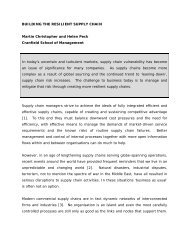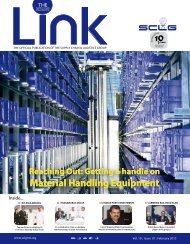You also want an ePaper? Increase the reach of your titles
YUMPU automatically turns print PDFs into web optimized ePapers that Google loves.
44 Banking & Finance<br />
Benefits to sellers<br />
• Speed and security of the<br />
transaction processing chain, from<br />
verification and authorisation to clearing<br />
and settlement.<br />
• Freedom from more costly labour,<br />
materials, and accounting services that<br />
are required in paper-based processing.<br />
• Better management of cash flow,<br />
inventory, and financial planning due to<br />
swift bank payment.<br />
• Incremental purchasing power on<br />
the part of the consumer.<br />
• Cost and risk savings by eliminating<br />
the need to run an in-house credit<br />
facility.<br />
A dramatic example of the<br />
efficiencies created by electronic<br />
payments can be seen in the public<br />
sector, where governments have used<br />
innovations such as purchasing cards to<br />
reduce paperwork, enhance financial<br />
controls and create more robust<br />
accounting and financial data.<br />
Convenience<br />
Anyone who has searched through<br />
pockets for exact change for parking,<br />
fumbled with foreign currency, paid<br />
exorbitant foreign exchange<br />
commissions, tried to cash a cheque in<br />
another country, or been concerned<br />
about carrying a large roll of banknotes<br />
can appreciate the convenience of<br />
payment cards.<br />
Fundamental to this convenience is<br />
virtually ubiquitous acceptance and<br />
utility – whether it’s an apparel store in<br />
Paris or a crafts shop in Nepal. Payment<br />
cards work in brick-and-mortar<br />
environments, over the phone, on the<br />
Internet and through the post.<br />
Applications are underway that support<br />
new uses such as recurring payments,<br />
insurance and payroll disbursements,<br />
rent and utility bills, and small-ticket<br />
transactions such as vending machines<br />
and car parks.<br />
Consumers place an enormous value<br />
on convenience – the sheer convenience<br />
of being able to access cash at an ATM or<br />
conduct a transaction directly at the<br />
point of sale with a credit or debit card<br />
clearly has had an impact on economic<br />
growth.<br />
Security<br />
A lost or stolen card is replaceable –<br />
lost or stolen cash isn’t. The guarantee<br />
that associations provide against misuse<br />
or theft of cards is something that<br />
consumers value. The electronic<br />
payment system provides additional<br />
insurance by facilitating dispute<br />
resolution in the case of unsatisfactory<br />
receipt of goods and services. This takes<br />
on increasing importance with the<br />
expansion of e-commerce.<br />
Sellers also gain from the security of<br />
electronic payments. A secure<br />
electronic system reduces risks of theft<br />
and loss to payments and receipts, and<br />
curbs the potential for pilferage and<br />
misplaced funds throughout the cash<br />
chain.<br />
Contd.from page: 42<br />
concerned. For instance, is time limit a<br />
question of procedural law (as in<br />
England) or of material law (as in<br />
Germany)? How are contractual time<br />
limits to be incorporated into a contract<br />
in order to make them binding? Is it<br />
possible to interrupt the running of time<br />
(prescription) and, if so, how? Can the<br />
period of prescription be extended? Is it<br />
automatically extended by negotiation?<br />
Is it the duty of the court to dismiss a<br />
prescribed (time-barred) claim even if<br />
the defendant did not invoke the<br />
argument of prescription? The list goes on.<br />
In the light of the foregoing, the first<br />
conclusion to be drawn is that<br />
prescription is not uniform at all,<br />
varying even from country to country.<br />
Things would be far less complicated if<br />
there was only one time limit, such as<br />
one year, which may be applied in all<br />
jurisdictions throughout the shipping<br />
world. But, while unifying the period<br />
of prescription would answer the first<br />
question of how long the time limit is,<br />
it would not address the many other<br />
and in some cases more difficult<br />
questions as mentioned above. There<br />
is also the danger that harmonising the<br />
period of prescription in the shipping<br />
industry would lead to disharmony in<br />
national legislation, so in fact, very<br />
little would be gained by creating one<br />
uniform time limit. Instead, it is<br />
believed, that there needs to be<br />
harmonization of different legal<br />
systems which would entail hard work.<br />
Supply Chain & Logistics Group | www.sclgme.org

















